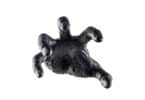The ketamine experience is an interesting one, but not always written about correctly. I hope my personal story helps to shed light on ketamine as a possible treatment, but one that might not work for everyone. This article details my second ketamine infusion.
First, my personal ketamine history
Before getting into my second infusion, I want to share a little history on my previous ketamine experiences in life…as in, the recreational ones. There are people out there with way more recreational ketamine experience than me, but I have some, and it differs greatly from my medical experience with the drug.
As a drug bought illicitly, I can’t say how pure it was, and that’s important. I also wasn’t doing infusions, or sitting in a doctor’s office so the set and setting were entirely different. I was hanging out with my boyfriend at the time, and a group of friends. There were other drugs around, and other more experienced ketamine users. As is the standard way for recreational use, I snorted the drug in lines.
What I remember most is something I didn’t feel in the doctor’s office. That dissociation effect. Ketamine for me at that time was like feeling my brain pull in different directions. It’s short acting, especially when snorted, and the effects rose and fell within about a half hour. I can’t say I loved the effect, and I didn’t want to do anymore past a certain point, but it was definitely a strong reaction where I truly felt like I was floating, and like my brain was literally pulling apart. There was no specific anxiety associated with these occurrences. I just personally found the feeling strange. Not bad, just strange.
Thanks for stopping by. Sign up for the Cannadelics Weekly Newsletter so you never fall behind; and get yourself access to sweet deals on cannabis flowers, vapes, edibles, smoking paraphernalia, other equipment, cannabinoid compounds (like delta-8), and so much more. Go ahead and pick your perfect products!
It’s worth mentioning that I was with people doing way more than I was. For as much as ‘k-holes’ are spoken of, I never witnessed anyone going into one. A k-hole is actually pretty simple, it means getting yourself to anesthetic levels. Ketamine is an anesthetic which is used for surgeries, so even if you take too much for recreational use, the most you’ll generally do is anesthetize yourself. Again, I never saw this happen, though I really thought I would with how some of the people around me were using it. I expect it takes quite a bit to get to that state.
In terms of my recreational use, I found ketamine an interesting experience, but not one I felt the need to replicate past a point. I did do it many times within a few months, before not really feeling the need to do it again. I cannot say whether or not it helped my mental state at that time, as I wasn’t paying attention to this. My doctor for infusions, asked about this point specifically. What I can say is that I enjoyed it more in those recreational days, than I did medically, which may – or may not – have to do with the set and setting as big factors in response.
What I can also say, is that the response was different. It’s possible I never got a high enough dose doing it medically, but I did have enough to make me feel plenty sick after the first infusion, something I didn’t experience as much when I took it as a recreational drug. I cannot explain the differences any further, or why it turned out the way it did. I can only say this is what happened. Click the link below for more details on the first infusion.
The second infusion – how it went
For my second infusion I was given no sedation beforehand. As there is debate over whether benzodiazepines can hinder ketamine progress, I thought it best to do without. After all, I had done one, I wasn’t quite as freaked out about an IV sitting in my arm. This time it was put in my arm, since my hand was still bruised from the first infusion. As it turns out, the anxiety I experienced the first time, was less likely due to the setting, than the ketamine itself. Also, it probably didn’t help that to get the IV in my arm, the anesthesiologist squirted blood all over my leg.
This time, without any sedative to provide anxiolytic effects, I felt the full force of the ketamine-induced anxiety. Whereas its written that most people have a relaxing experience, I felt like I wanted to get up and move. My doctor saw it as well, and when the session ended, he didn’t ask if I wanted to schedule another infusion. Instead he said to see how things went and we’d plan from there. Hours later, I still felt more unsettled than I had when I went in, and I had a smaller dose given to me than the first time.
I also want to add in, that I had to ask for a smaller dose. Perhaps this point is indicative of the place I went, and it not being a clinic specifically for such treatments. I had to prod the doctor to give him my experience from the time before, and the guy actually tried to argue with me a bit about my own feelings. I fully admit I was unhappy with this, and it made me lose some faith in the doctor. As a patient, your experience should always be listened to by your doctor, and they should ask for it, and keep track of progress. This did not happen, and the doctor seemed truly bent on trying to reason me out of thinking I had had a sub-par experience.

In the rush to excitement over ketamine, some realities of the lack of information are sometimes ignored. This is quite similar to the CBD craze of a few years ago that died down quite a bit in the realization of these realities. Some people benefit from it, some don’t. Some don’t appreciate the response at all. Ketamine is no different. And it makes it that much more important for doctors to pay attention, and to follow-up. If you find yourself in a situation like mine, don’t hesitate to find a better provider who will take your own experience seriously. It’s also literally how we gain information on the subject in general.
I did not get any benefit to my sleep after that second session, and I wonder if it was the ketamine in conjunction with the benzodiazepines that actually worked the first time, and perhaps the bigger dose which was enough to leave me feeling sick for many hours. This time around, with half the dose given, I had way less nausea, and overall fatigue. But it did amp up my anxiety for hours afterward.
The takeaway
There is often a desire for something to work, even if it doesn’t. Truth be told, if we look at the ketamine research, at no point does it say 100% of people are served positively by it. In fact, the numbers seem to vary by study. Many clinics like to report numbers like 70-80% that get a positive response, and this could be true, but it could also be inflated.
In much research the numbers for positive results are far less, closer to 50-60%. And that’s great, it means a lot of people that otherwise have issues with treatment, can reap benefits from this therapy. However, if your experience sounds more like mine, be aware that this might be the end of the ketamine option. Plenty of us are non-responders, and that’s okay too. I promise, there’s nothing wrong with you if you’re not one of those immediately happier people. It just means your answer likely lies elsewhere.
In absolutely no way am I encouraging people not to try this treatment. The reality of therapy in general is that its not one-size-fits-all. There is trial and error, there is failure at times, there is disappointment. I felt that disappointment as well, but I also understood after several hours of not getting a better response, followed by several days of nothing, that I could no longer hope to include myself in the responder category. This is a reality of this treatment, and one that people undergoing it should keep in mind.
It also might be good to bear in mind that if you don’t always respond to medications like the general population, that a drug meant for treatment resistance, doesn’t have to be different. I didn’t have the most typical response, but I did have a standard response. Go ahead, look up ‘ketamine-induced anxiety’, it’s a thing. Just not the thing that people are hoping for when undergoing this treatment.

If you believe ketamine can help you, give it a shot. The benefit to a therapy like this is that it hasn’t proven deadly. A bad experience, much like a bad psychedelic trip, eventually subsides. You won’t be worse off than you started. And at least you’ll have more information for yourself. My advise though, is that if you are following a pattern that shows no real response, be realistic with yourself.
Unless you have tons of money to throw around, and enjoy discomfort, it’s sometimes just as important to know when to quit, as it is to try in the first place. Ketamine seems to be a great option for many people. But if you are not one of them, don’t waste your life trying to be what you’re not, and move on to other options. It’s what I’ll be doing.
Conclusion
The reality of any treatment is that it doesn’t work for everyone. This is something I encountered with my second ketamine infusion. Though the reaction does not rule out a possible good effect, in my case, it no longer seemed beneficial to keep trying. Both me and my doctor agreed on that. He might not have been good about listening, but even he could tell it probably wouldn’t be beneficial to continue. It does not have to take six sessions to understand this. I also haven’t ruled out trying it again in the future, with a different doctor who is more responsive to my needs.
Thanks for stopping by the site!! We’re glad you made it to Cannadelics.com; a news publication where we work hard every day to bring you the best in cannabis and psychedelics reporting. Join us daily to keep up with everything important going on, and sign up for the Cannadelics Weekly Newsletter, so you’re never late to get the news.
For more information on my personal ketamine experience, you can revisit:
My Ketamine Experience: Part One – The First Infusion
or go onto
My Ketamine Experience: Part Three – What It Means To Be a Non-Responder, and Alternate Therapies









